|
|
|
Sort Order |
|
|
|
Items / Page
|
|
|
|
|
|
|
| Srl | Item |
| 1 |
ID:
167640
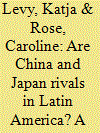

|
|
|
|
|
| Summary/Abstract |
This article investigates whether the People’s Republic of China and Japan perceive each other as rivals in Latin America (LA; both the Chinese and Japanese governments tend to refer to the region as Latin America and the Caribbean (LAC), but for the purposes of this article we focus mainly on LA), and what impact such a perception might have on their foreign policy decision-making. We take LA as a case study because China’s and Japan’s recent (re-)engagement there began almost simultaneously in the early 2000s, and has developed against the background of domestic leadership transitions, growing demands for energy and markets, as well as international political agendas in which LA might play a key role. Developing the work of Thompson [(1995). Principal rivalries. Journal of Conflict Resolution, 39 (2), 195–223; (2001). Identifying rivals and rivalries in world politics. International Studies Quarterly, 45(4), 557–586] and Vasquez [(1993). The War Puzzle. Cambridge, MA: Cambridge University Press; (1996). Distinguishing rivals that go to war from those that do not: Aa quantitative comparative case study of the two paths to war. International Studies Quarterly, 40 (4), 531–558] on rivalry, in combination with perception theory [Jervis, R. (1976). Perception and misperception in international politics. Princeton, NJ: Princeton University Press], the article suggests three indicators by which to measure the extent to which China and Japan might perceive each other as rivals. Drawing on content analysis of a range of Chinese- and Japanese-language official writing, news reports, and academic analysis, the article argues that, despite some media representation of China and Japan as competitors for resources and power in LA, in fact mutual perceptions concerning rivalry have not affected LA policy decisions of these two countries.
|
|
|
|
|
|
|
|
|
|
|
|
|
|
|
|
| 2 |
ID:
167638
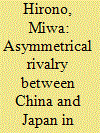

|
|
|
|
|
| Summary/Abstract |
To what extent is China–Japan rivalry a global phenomenon, and what is the nature of the rivalry they engage in outside their own region? Literature on Sino-Japanese rivalry abounds, but it pays scant attention to the relevance of the rivalry outside East Asia. This article argues that Sino-Japanese rivalry has indeed become a global phenomenon, that various forms of the rivalry are evident in Africa, and that they are mostly of an asymmetrical nature. Quantitatively, China’s contribution to Africa is far greater than that of Japan, with the exception of foreign direct investment (FDI). Qualitatively, though, Japan has a stronger sense of the rivalry than China has, revealing a psychological aspect to the asymmetry as well. Contextually, the types of activity that Chinese and Japanese actors carry out in Africa are not necessarily the same, which makes the rivalry all the more asymmetrical. The rivalry has become more apparent recently, not only because of the rise of China but also because of a change in the meaning of ‘Africa’ – from a region of ‘poverty’ and ‘hunger’ to a region of ‘economic opportunities’. That said, Africa – to a greater or lesser degree in each of its countries – still suffers from conflict and instability. As a result, the ability of Japan and China to exert power and influence throughout Africa is somewhat restricted.
|
|
|
|
|
|
|
|
|
|
|
|
|
|
|
|
| 3 |
ID:
117778
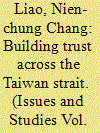

|
|
|
| 4 |
ID:
174543
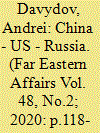

|
|
|
|
|
| Summary/Abstract |
This article describes the recent events in the relations between China, the United States, and Russia (the "Big Three" in the struggle to shape a new world order), their role and potentialities in the process under conditions of the raging coronavirus pandemic, and the development prospects for their relations in the foreseeable future.
|
|
|
|
|
|
|
|
|
|
|
|
|
|
|
|
| 5 |
ID:
115091
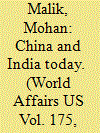

|
|
|
|
|
| Publication |
2012.
|
| Summary/Abstract |
Just as the Indian subcontinental plate has a tendency to constantly rub and push against the Eurasian tectonic plate, causing friction and volatility in the entire Himalayan mountain range, India's bilateral relationship with China is also a subtle, unseen, but ongoing and deeply felt collision, the affects of which have left a convoluted lineage. Tensions between the two powers have come to influence everything from their military and security decisionmaking to their economic and diplomatic maneuvering, with implications for wary neighbors and faraway allies alike. The relationship is complicated by layers of rivalry, mistrust, and occasional cooperation, not to mention actual geographical disputes.
|
|
|
|
|
|
|
|
|
|
|
|
|
|
|
|
| 6 |
ID:
084212
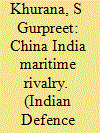

|
|
|
| 7 |
ID:
146025
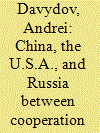

|
|
|
|
|
| Summary/Abstract |
The author analyzes sensitive issues (i.e. pressing problems) in mutual relations between China and Russia, and China and the U.S.A. He also assesses the development prospects of U.S.-PRC-RF ties amid a changing global architecture
|
|
|
|
|
|
|
|
|
|
|
|
|
|
|
|
| 8 |
ID:
123051
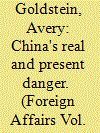

|
|
|
|
|
| Publication |
2013.
|
| Summary/Abstract |
Much of the debate about China's rise in recent years has focused on the potential dangers China could pose as an eventual peer competitor to the United States bent on challenging the existing international order. But another issue is far more pressing. For at least the next decade, while China remains relatively weak compared to the United States, there is a real danger that Beijing and Washington will find themselves in a crisis that could quickly escalate to military conflict. Unlike a long-term great-power strategic rivalry that might or might not develop down the road, the danger of a crisis involving the two nuclear-armed countries is a tangible, near-term concern -- and the events of the past few years suggest the risk might be increasing.
|
|
|
|
|
|
|
|
|
|
|
|
|
|
|
|
| 9 |
ID:
119369
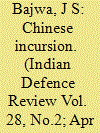

|
|
|
| 10 |
ID:
157510
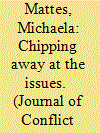

|
|
|
|
|
| Summary/Abstract |
Disputants might resolve their disagreements in a piecemeal fashion, addressing a subset of the issues at a time. How viable is such a strategy? I argue that partial settlements signal the desire to resolve disagreements and can lay the foundation for additional cooperation by building trust and/or demonstrating the benefits of dispute resolution. As a result, partial settlements should be associated with the resolution of remaining disagreements. Yet, scholars have questioned whether pursuing a piecemeal approach may be more harmful than helpful, and a systematic empirical test of these competing predictions is necessary. Using data from worldwide territorial claims between 1919 and 2001, I find a strong positive correlation between partial settlements and comprehensive dispute resolution. In the shorter run, partial settlements are also associated with an increased likelihood for peaceful negotiations, but there is only limited evidence that they reduce conflict before all aspects of the claim are resolved.
|
|
|
|
|
|
|
|
|
|
|
|
|
|
|
|
| 11 |
ID:
182544


|
|
|
|
|
| Summary/Abstract |
Why do militant groups turn on each other? This behavior is somewhat puzzling, since such groups are often on the same side of a conflict. A growing body of literature seeks to understand political violence by looking at cooperative and competitive relationships among non-state actors. Debates continue about the sources of militant group rivalry. We argue that shared motivations, especially ethnic motivations, along with power differences among groups should help explain inter-group fighting. Our analysis uses new dyadic data on rivalry among the militant groups of Africa and Asia since 1990. Unlike some previous studies, we analyze both terrorist and insurgent organizations. Results suggest that pairs of groups with a shared ethnic identity are more likely than others to have rivalrous relationships. Power asymmetry is also somewhat associated with rivalry, but interaction models indicate that the association is only statistically significant in the presence of shared ethnic motivations.
|
|
|
|
|
|
|
|
|
|
|
|
|
|
|
|
| 12 |
ID:
120286
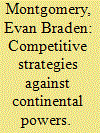

|
|
|
|
|
| Publication |
2013.
|
| Summary/Abstract |
This article makes three arguments about the Sino-American competition, the Sino-Indian rivalry, and the US-India partnership. First, past maritime-continental rivalries suggest that China will pose a greater challenge to American interests as it confronts fewer threats on land, while the US may require continental allies to counter-balance China's rise. Second, whereas a Sino-Indian continental security dilemma could benefit the US by compelling China to invest in capabilities that do not threaten it, a Sino-Indian maritime security dilemma could have the opposite effect. Third, Washington should consider India as a prospective continental ally rather than a potential maritime partner.
|
|
|
|
|
|
|
|
|
|
|
|
|
|
|
|
| 13 |
ID:
124962


|
|
|
|
|
| Publication |
2013.
|
| Summary/Abstract |
The article discusses Russian and Greek rivalry over the influence in the Patriarchates of Jerusalem and Antioch from the end of the Egyptian occupation to the Young Turk Revolution. While Greece ultimately aimed at including Orthodox Arabs in a Pan-Hellenic nation, Russian private and state actors were motivated by the cultural and political commitment to the defence of Orthodoxy from western inroads. Throughout this period, Russian diplomats were able to continue their traditional partnership with many Ottoman Greek prelates even after the Bulgarian schism of 1872. But when their leadership seemed to be the cause of mass defections from orthodoxy, Russian foreign policy makers from local consuls to the tsar were drawn into supporting the restoration of native Arab control. The article brings fresh archival evidence to put into context the development of some of the earliest modern Arab autonomous institutions. It also contributes to the discussion of the strength of dynastic and religious identities before 1914.
|
|
|
|
|
|
|
|
|
|
|
|
|
|
|
|
| 14 |
ID:
100387
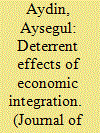

|
|
|
|
|
| Publication |
2010.
|
| Summary/Abstract |
Economic interdependence and international conflict studies have traditionally focused on the role of bilateral trade on direct deterrence, mostly omitting its indirect effects on third-party states. While scholars in the extended deterrence literature have examined the role of defender-target trade in deterring aggressors, most empirical research has remained limited to immediate deterrence and neglected general deterrence. This article synthesizes these literatures and goes beyond the dyad-level analysis in trade-conflict studies by focusing on the deterrent effects of trade. I claim that trade ties between the defender and target are not sufficient for extended general deterrence. This is mainly because international trade by itself is a poor indicator of the extent to which the target is an economically important friend of the defender, worth defending against aggressors. Empirical analysis of militarized disputes between rival states in the post-1945 period supports this point and shows that extended deterrence success is most likely in cases where the defender and target are economically integrated through regional trade institutions as well as conducting heavy trade. Economically minded defenders can successfully generate credible signals of resolve if they have institutional ties with their important trade partners.
|
|
|
|
|
|
|
|
|
|
|
|
|
|
|
|
| 15 |
ID:
148050
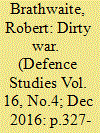

|
|
|
|
|
| Summary/Abstract |
The utilization of chemical weapons to quash domestic rebellion is a drastic action for a regime facing domestic challengers to take, especially given the reputation costs and risk of international intervention. However, recent developments have illustrated that some regimes have contemplated and implemented extraordinary measures (including the use of chemical munitions) to quash rebellion. This study addresses the question of why some states utilize chemical weapons against domestic challengers while others refrain from this level of state repression. I argue that the utilization of chemical weapons has both domestic and international elements. Specifically, that ethnic cleavages that lead to secessionist challenges and factors associated with inter-state rivalry impact the likelihood that a state utilizes the employment of chemical munitions. I test my argument and other explanations regarding repression with a casestudy approach utilizing captured Iraqi Government documents comparing Iraq’s Al-Anfal campaigns with developments during the recent Syrian Civil War.
|
|
|
|
|
|
|
|
|
|
|
|
|
|
|
|
| 16 |
ID:
181665


|
|
|
|
|
| Summary/Abstract |
A common explanation for the increasing polarization in contemporary American foreign policy is the absence of external threat. I identify two mechanisms through which threats could reduce polarization: by revealing information about an adversary that elicits a bipartisan response from policymakers (information mechanism) and by heightening the salience of national relative to partisan identity (identity mechanism). To evaluate the information mechanism, study 1 uses computational text analysis of congressional speeches to explore whether security threats reduce partisanship in attitudes toward foreign adversaries. To evaluate the identity mechanism, study 2 uses public opinion polls to assess whether threats reduce affective polarization among the public. Study 3 tests both mechanisms in a survey experiment that heightens a security threat from China. I find that the external threat hypothesis has limited ability to explain either polarization in US foreign policy or affective polarization among the American public. Instead, responses to external threats reflect the domestic political environment in which they are introduced. The findings cast doubt on predictions that new foreign threats will inherently create partisan unity.
|
|
|
|
|
|
|
|
|
|
|
|
|
|
|
|
| 17 |
ID:
132349
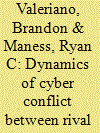

|
|
|
|
|
| Publication |
2014.
|
| Summary/Abstract |
Much discussion of the concept of cyberwar, cyber conflict, and the changing dynamic of future security interactions is founded upon the study of what could be, conjured through spectacular flights of the imagination. The goal of this research article is to exhaustively collect information on cyber interactions between rival states in the last decade so that we can delineate the patterns of cyber conflict as reflected by evidence at the international level. The field of cyber security needs a clear return to social science in order to be able to definitively engage the cyber debate with facts, figures, and theory. To that end we provide a dataset of cyber incidents and cyber disputes that spans from 2001 to 2011. Our data include 110 cyber incidents and 45 cyber disputes. Further, we test our theory of cyber conflict which argues that restraint and regionalism should be expected, counter-intuitive to conventional wisdom. We find here that the actual magnitude and pace of cyber disputes among rivals does not match with popular perception; 20 of 126 active rivals engaged in cyber conflict. The interactions that are uncovered are limited in terms of magnitude and frequency suggesting cyber restraint. Further, most of the cyber disputes that are uncovered are regional in tone, defying the unbounded nature of cyberpower. The coming era of cyber conflict may continue to exhibit these patterns despite fears mentioned in the discourse by the media and cyber security professionals.
|
|
|
|
|
|
|
|
|
|
|
|
|
|
|
|
| 18 |
ID:
189257
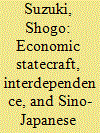

|
|
|
|
|
| Summary/Abstract |
China’s increasingly active economic diplomacy in recent years has often been deeply linked to its geostrategic interests. Japan is said to be watching this development with alarm. Analysts have often claimed that this has resulted in Sino-Japanese rivalry, where the Japanese see any gains made by China in zero-sum terms, and make concerted efforts to counter China’s growing influence. This article, however, is critical of such views. While elements of rivalry may indeed be visible in some aspects of Sino-Japanese relations, it would be premature to apply this perspective to economic statecraft, which is inherently multifaceted. This article claims that too much attention has been paid to the strategic aspects of Chinese economic statecraft at the expense of economic/commercial ones that could foster cooperative relations between Beijing and Tokyo. It argues that Japan does not hold a monolithic view that Chinese diplomatic activities in the economic realm are an axiomatic threat to Japanese security interests, and it remains premature to say that Japan and China are ‘rivals’ in the realm of economic statecraft. Future analysis in this area needs to pay greater attention to the complicating effects that economic interdependence can have in strategic policies.
|
|
|
|
|
|
|
|
|
|
|
|
|
|
|
|
| 19 |
ID:
105017
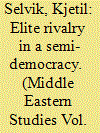

|
|
|
|
|
| Publication |
2011.
|
| Summary/Abstract |
Kuwait's liberalization of the press and publication law in 2006 sparked a threefold increase in the number of Arabic language newspapers that defied conventional wisdom about print media decline and also survived the world financial crisis. The article provides a political explanation for this puzzle, arguing that newspapers serve as political instruments in elite rivalries in Kuwait's semi-democratic setting. It qualifies the idea of newspapers as civil society institutions and shows how political control is reproduced in a liberal context. It thereby contributes to our understanding of the role of the press in hybrid regimes.
|
|
|
|
|
|
|
|
|
|
|
|
|
|
|
|
| 20 |
ID:
142035
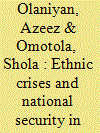

|
|
|
|
|
| Summary/Abstract |
The article focuses on the interface between ethnicity and national security in Nigeria. It critically explores the negative mobilization of ethnicity in Nigeria's fourth republic, and how this has been shaping (and reshaping) the democratization process, particularly in the management of cooperation and conflict over contestations for power and other resources. The re-democratization of Nigeria in 1999 has been preceded with high expectations of meaningful reductions in the high level of insecurity witnessed under the long years of military suzerainty. However, this has not been the case. Rather, what is obtained is an increase in national insecurity on a much larger scale. This article argues that one of the banes of national security in the Nigerian state is ethnic politics, which continues to witness changes in context and character with grave consequences for the future of democracy. The central argument is that ethnicity has always been a major driver of politics and conflicts in Nigeria and the trend is not likely to change anytime soon.
|
|
|
|
|
|
|
|
|
|
|
|
|
|
|
|
|
|
|
|
|